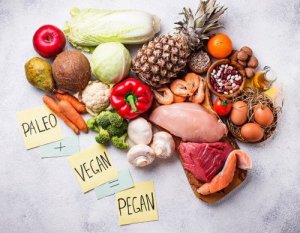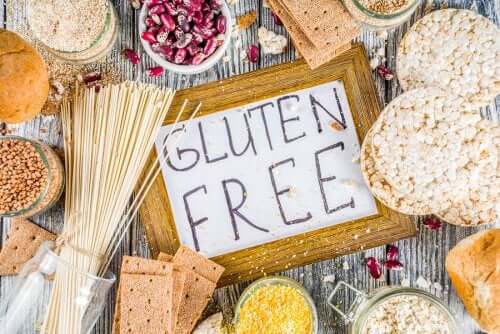The Pegan Diet - What You Should Know

The foundation of the pegan diet is the consumption of plant-based food. It’s basically a combination of the paleo diet and the vegan diet. The paleo diet is the one that supposedly follows the eating habits that our ancestors had during the Paleolithic period.
What’s the pegan diet about?

The pegan diet was developed by the American nutritionist Mark Hyman. The main idea of the paleo diet that it has in common with the pegan diet is to not consume processed foods.
However, it’s not just about eating the same food as our ancestors, but also about how they consumed it. This is the reasoning behind avoiding refined foods, cold cuts, sausages, etc.
As we said before, the pegan diet is about eating only food of plant origin, but it also means ensuring that it isn’t processed food. For this reason, food such as tofu or tempé wouldn’t be acceptable.
The keys to the pegan diet
The success of the pegan diet lies in its ingredients. This is because they must be natural and free of chemicals and GMOs. Also, 75% of the food must be based on vegetables, which must be of natural and proven ecological and sustainable origin.
Healthy fats are necessary since they have a fundamental role in the health of your body. Avocado, coconut oil, nuts, or extra virgin olive oil are more than welcome. Healthy fats provide essential fatty acids, among other nutrients.
In the diet, the meat must be from grass-fed animals, the fish must be wild-caught and the eggs, organic. Legumes are strongly encouraged, especially lentils. People following this diet should eat one cup of legumes per day.
They must also eat gluten-free cereals such as quinoa, amaranth, gluten-free oats, corn, rice or millet. However, you must eliminate sugars and refined cereals. This is because the excessive consumption of sugars increases your risk of cardiovascular diseases, diabetes, and excess weight.
In addition, the pegan diet suppresses dairy and suggests replacing it with vegetable drinks such as soy or oat milk.
You may also be interested in: What Do Successful Diets Have in Common?
Benefits of the pegan diet
This diet doesn’t exclude any ingredient that’s fundamental for your body’s well-being. Thus, it gives you everything you need to have enough energy and function properly with its careful balance of ingredients. Its main properties are:
It balances blood glucose and insulin levels

Given that this is a diet with low glycemic levels, it balances the levels of insulin and blood glucose. This is because it contains little to zero refined flours and carbohydrates.
Following the pegan diet apparently helps improve the symptoms of diabetes, stress, anxiety and other illnesses associated with blood sugar disorders.
It regulates cholesterol
Its action on cholesterol also reduces the risk of cardiovascular diseases. Also, it improves inflammation thanks to the contribution of omega-3, which you can obtain from flaxseed, bluefish, algae and nuts, and a lower meat consumption.
Read also: Why are Gluten-free Diets Harmful?
It has a low toxicity
This type of diet promotes the consumption of local, ecological, and non-toxic products and raising animals with respect. Also, it could help you to lose and weight and keep it low.
Is the pegan diet healthy?

The question is whether the pegan diet is truly healthy and whether it can help you lose and maintain optimal weight. The biggest problem with this diet is that it might be too strict due to the fact that it’s a combination of both vegan and paleo diets.
In addition, it also limits the consumption of legumes, some proteins of vegetable origin and any processed food, even if it’s minimal. Consult a nutritionist before making a decision to follow it.
Conclusion
You must remember that, so far, there’s no evidence to show that this type of diet has any advantage over other types of diets, even less strict ones.
Despite its benefits, the other two diets that comprise the pegan diet (paleo and vegan) are less strict and might be better in the long term.
All cited sources were thoroughly reviewed by our team to ensure their quality, reliability, currency, and validity. The bibliography of this article was considered reliable and of academic or scientific accuracy.
- Srour B., Fezeu LK., Kesse Guyot E., Alles B., et al., Ultra processed food intake and risk of cardiovascular disease: prospective cohort study. BMJ, 2019.
- Rozenberg S., Body JJ., Bruyere O., Bergmann P., et al., Effects of dairy products consumption on health: benefits and beliefs–a commentary from the belgian bone club and the european society for clinical and economic aspects of osteoporosis, osteoarthritis and musculoeskeletal disease. Clacif Tissue Int, 2016.
- Abdelhamid AS., Brown TJ., Brainard JS., Biswas P., et al., Omega 3 fatty acids for the primary and secondary prevention of cardiovascular disease. Cochrane Database Syst Rev, 2018.
This text is provided for informational purposes only and does not replace consultation with a professional. If in doubt, consult your specialist.








